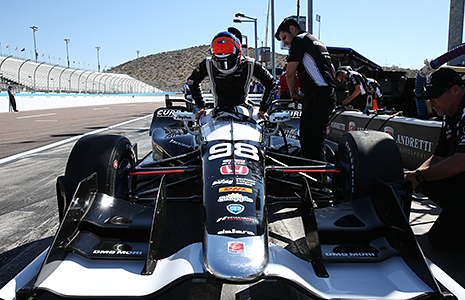(This is the first of a four-part series by noted motorsports reporter Will Buxton chronicling the incredible 2016 journey of Alexander Rossi, from little-known Verizon IndyCar Series rookie to champion of the historic 100th Running of the Indianapolis 500 presented by PennGrade Motor Oil. Stay tuned throughout the week for the final installments.)
You’ve seen the headlines. You know the story. If you stood in the Indianapolis Motor Speedway grandstands 12 months ago, you saw him cross the line. You know how this one ends.
A year ago over the hallowed “yard of bricks,” one of the unlikeliest outcomes in the history of the Indianapolis 500 Mile Race unfolded in front of the disbelieving eyes of the world as Californian rookie Alexander Rossi overturned the most impossible odds to take victory in the 100th running of the race. But this isn’t just a story of an audacious strategy call. It’s not just the fact he ran longer on one tank of ethanol than anyone believed possible. Nor that he did so as a rookie and the first American to win in his debut since Louis Meyer in 1928.
Alexander Rossi’s story is far more improbable than that.
You see, three months before the 2016 Indianapolis 500, Alexander Rossi didn’t have a drive. In anything. He hadn’t raced in a U.S. series in eight years. He’d never been to an INDYCAR paddock and he’d never even seen an oval firsthand.
Rossi grew up fascinated by the allure of Formula One. That was his life’s goal and his one true aim. Leaving behind friends and family, growing up alone and away from home in Europe, the young racer had to mature and man up fast.
He won at every level, becoming widely respected in a racing world where Americans are the rarest of breeds. He fought his way past every obstacle and ultimately achieved his dream of racing in the self-proclaimed highest echelon of global open-wheel racing in 2015. Yet such is the cruel hand of fate that, just months after making his debut, he was to have it all snatched away when money and politics spoke louder than talent and potential. Alexander Rossi was without an F1 ride.
Unknown to him, America had been watching all along. A phone call from Michael Andretti led to a meeting and an offer of a seat in Bryan Herta’s satellite team that was merging with Andretti Autosport in the Verizon IndyCar Series.
“My dad (Pieter) and I asked (questions) for 20 minutes and literally decided then and there in the Andretti conference room,” Rossi laughs when recalling the meeting. “We’d come on a whim, flown to Indianapolis and right there we signed a deal to race in a championship we knew nothing about. We would have just two days of testing and then we were racing.”
 The first challenge for Rossi was getting used to the cars. Rossi had been racing F1 machinery that used a 1.6-liter, V-6 turbo hybrid engine with the cars weighing in at around 1,500 pounds. In the Verizon IndyCar Series, Rossi would have a 2.2-liter, V-6 twin-turbocharger powering a car that weighed 100 pounds more. He’d need to adapt his technique to suit it.
The first challenge for Rossi was getting used to the cars. Rossi had been racing F1 machinery that used a 1.6-liter, V-6 turbo hybrid engine with the cars weighing in at around 1,500 pounds. In the Verizon IndyCar Series, Rossi would have a 2.2-liter, V-6 twin-turbocharger powering a car that weighed 100 pounds more. He’d need to adapt his technique to suit it.
“In Europe, it’s all about getting your car straight on (corner) entry and exit and being very precise,” he explained. “In INDYCAR, it’s literally however fast you are comfortable firing a car into the corner and then just holding on. It’s about using an ungodly amount of downforce in the middle of the corner to get lap time.”
While Rossi at least had reference points at road and street courses, he’d never so much as stepped onto an oval in his life. First up was Phoenix Raceway (at right) in the second race of the season at the beginning of April 2016.
“That place is a terrifying little monster from hell,” Rossi grins but not joking. “The car doesn’t want to do it and the amount of corrections you have to make are just insane. You qualify (two laps) in 35 seconds and you’re just holding your breath for the whole thing.
“But even there, you’re running road-course wings and the cars are still generating quite a bit of downforce, so it’s completely irrelevant in terms of your understanding of a track like Indianapolis. That was the biggest question mark coming into the month of May. I had no idea what to expect and what lapping consistently at over 230mph with little to no downforce was going to feel like.”
Next in Part 2: Finding his way at Indianapolis Motor Speedway, Rossi says, “It was diabolical.”